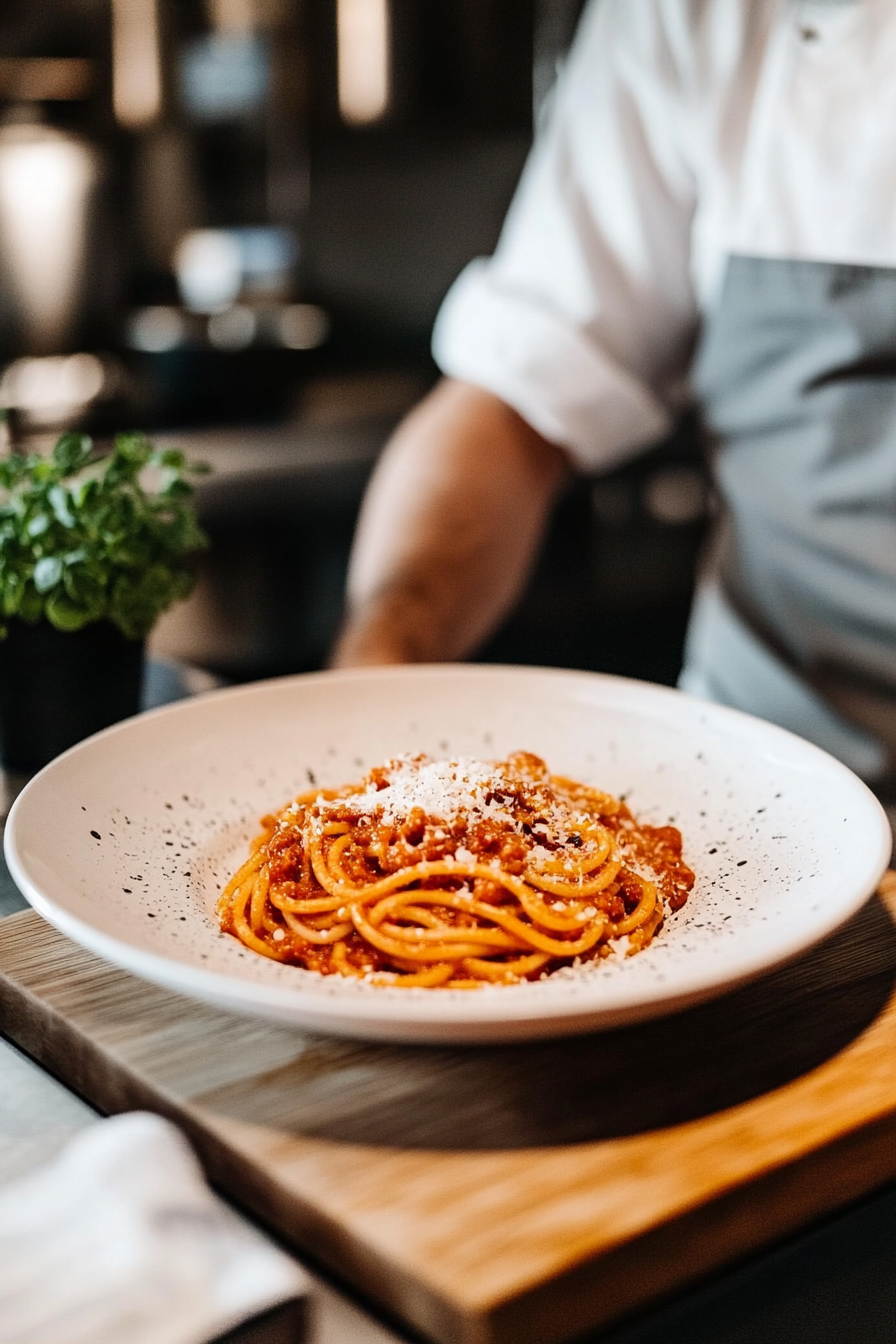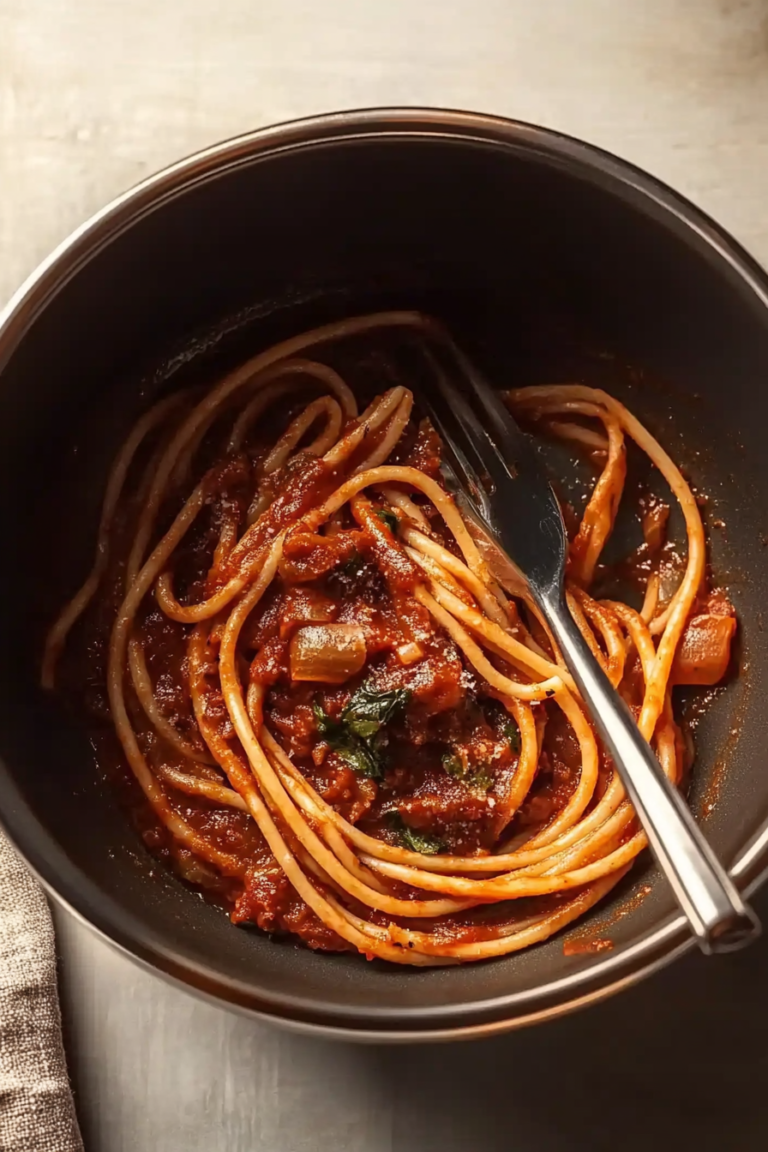Mastering Bucatini Allamatriciana
Bucatini Allamatriciana is a classic Italian pasta dish celebrated for its simplicity and rich flavor. This recipe centers on using bucatini pasta coated in a savory sauce made from guanciale, Pecorino Romano cheese, and ripe San Marzano tomatoes. Its appeal lies in the hearty and bold flavors achieved with minimal ingredients, making it perfect for home cooks seeking an authentic Italian experience without complexity.
The dish is naturally gluten-free if you use gluten-free pasta and focuses on high-quality components that bring out deep, satisfying tastes. Cooking the guanciale slowly allows the fat to render perfectly, creating a crispy texture that blends beautifully with the sauce’s balanced acidity and sweetness from the tomatoes. This makes bucatini allamatriciana an ideal choice for those craving a nutritious yet indulgent meal.
Thanks to its straightforward technique and classic ingredients, this dish offers an accessible yet impressive pasta experience, delivering rich flavor profiles that resonate with Italian culinary traditions.

Jump To
- 1. Mastering Bucatini Allamatriciana
- 2. Benefits and Advantages of Bucatini Allamatriciana
- 3. Essential Ingredients for Bucatini Allamatriciana
- 4. Dietary Substitutions to Customize Your Bucatini Allamatriciana
- 5. How to Prepare the Perfect Bucatini all’Amatriciana: Step-by-Step Guide
- 6. Mastering Bucatini all’Amatriciana: Advanced Tips and Variations
- 7. How to Store Bucatini all’Amatriciana: Best Practices
- 8. Nutritional Value of Bucatini all’Amatriciana
- 9. FAQs: Frequently Asked Questions About Bucatini all’Amatriciana
- 10. Authentic Bucatini all’Amatriciana: A Classic Recipe for Pasta Lovers
Benefits and Advantages of Bucatini Allamatriciana
Simple Preparation with Impressive Flavor
One of the main advantages is the recipe’s ease of preparation. With a few essential ingredients and minimal steps, you can achieve a restaurant-quality meal. The slow rendering of guanciale provides unlikely depth to the sauce, while the bucatini provides the ideal texture and bite, holding the sauce reliably.
Balanced Nutrition
This recipe offers a good mix of macronutrients. The guanciale and Pecorino Romano cheese provide quality protein and fats, while the pasta delivers carbohydrates for energy. San Marzano tomatoes add vitamins, antioxidants, and a balanced sweetness to the dish. Although moderately high in calories, it satisfies hunger effectively with its nutrient-rich components.
Authenticity and Tradition
Using traditional ingredients like guanciale, San Marzano tomatoes, and Pecorino Romano honors the dish’s origins in Amatrice, Italy. This authenticity enriches the dining experience by maintaining genuine flavors that have been cherished for generations. It’s a straightforward dish that connects home cooks with Italian culture and cuisine.

Essential Ingredients for Bucatini Allamatriciana
- 400 grams bucatini pasta (a thick hollow spaghetti)
- 150 grams guanciale (cured pork cheek), cut into strips (Authentic Guanciale: What It Is and How to Use It)
- 1 cup San Marzano tomatoes, hand-crushed or canned (Why San Marzano Tomatoes Are Best for Italian Sauces)
- 100 grams Pecorino Romano cheese, freshly grated (Understanding Pecorino Romano Cheese)
- ⅓ cup dry white wine
- 2 tablespoons extra virgin olive oil or strutto (pork lard)
- Freshly ground black pepper
- Salt (for pasta water and seasoning)
- Optional: Small amounts of onion or garlic (traditional recipes typically exclude these)
- Optional: Crushed red pepper flakes (for added heat, if desired)
Dietary Substitutions to Customize Your Bucatini Allamatriciana
Protein Alternatives
- Substitute guanciale with pancetta or a high-quality unsmoked bacon if guanciale is unavailable. While the flavor is less traditional, these alternatives provide a similar texture and richness.
- For a leaner option, consider turkey bacon or smoked tempeh to maintain the dish’s smoky, savory character.
Pasta Variations
- Bucatini is recommended for its hollow center which captures sauce effectively, but spaghetti, rigatoni, or other long pastas can be used.
- Gluten-free pasta options are excellent alternatives for those with dietary restrictions, without sacrificing taste.
Cheese Substitutions
- Although Pecorino Romano is traditional for its sharp and salty profile, Parmesan can be used for a milder flavor.
- Vegan or dairy-free cheese alternatives can be used though expect noticeable flavor differences.
Additional Flavor Adjustments
- While the classic recipe excludes garlic and onion, small quantities of either can be included for more aromatic depth if desired.
- For spice lovers, a pinch of crushed red pepper flakes will add a pleasant heat without overpowering the dish’s balance.
- Replace olive oil with strutto (pork lard) for a more traditional, richer taste, but olive oil is suitable for a lighter version.
Bucatini allamatriciana is flexible enough to allow for personal preferences while preserving its authentic heart and soul.
Check out our flavorful and easy-to-make Bruschetta Chicken Pasta recipe for another Italian-inspired favorite.

How to Prepare the Perfect Bucatini all’Amatriciana: Step-by-Step Guide
- First Step: Cut 150 grams of guanciale into thin strips. Heat 2 tablespoons of olive oil or strutto in a large skillet over medium heat. Fry the guanciale slowly until it becomes crispy and the fat is rendered.
- Second Step: Add ⅓ cup dry white wine to the skillet to deglaze, allowing the wine to evaporate completely while stirring.
- Third Step: Incorporate 1 cup hand-crushed San Marzano tomatoes into the skillet. Simmer gently for 15 to 20 minutes to thicken the sauce. Season with salt and freshly cracked black pepper to taste.
- Fourth Step: Meanwhile, cook 400 grams of bucatini pasta in well-salted boiling water until just before al dente. Reserve some pasta water and then drain the pasta.
- Fifth Step: Add the drained pasta to the sauce in the skillet. Toss thoroughly to coat. If needed, add reserved pasta water gradually to loosen the sauce and achieve a silky consistency.
- Final Step: Remove from heat and add 100 grams freshly grated Pecorino Romano cheese. Toss well, then serve immediately with an extra sprinkle of Pecorino and black pepper if desired.
Mastering Bucatini all’Amatriciana: Advanced Tips and Variations
Essential Tips
- Cook guanciale slowly over medium-low heat to extract all fat and create a crispy texture without burning.
- Use freshly grated Pecorino Romano for authentic sharpness and smooth blending with pasta.
- Avoid using onion or garlic to keep traditional flavors clean, but you can add a pinch of crushed red pepper flakes for heat.
- Reserve and use pasta water to adjust the sauce consistency and help it cling to the pasta.
- Ensure pasta is cooked al dente so it maintains texture when combined with sauce.
Variations to Try
- Swap bucatini for spaghetti or rigatoni if preferred or if bucatini is unavailable.
- Replace guanciale with pancetta or unsmoked bacon for a less intense flavor.
- Add fresh herbs cautiously after cooking—parsley adds freshness while basil lends aromatic notes.
Bucatini all’Amatriciana thrives on balance: crispy, salty guanciale meets sweet tomato sauce and sharp cheese for a dish that’s as simple as it is satisfying.
How to Store Bucatini all’Amatriciana: Best Practices
Refrigeration
- Cool leftovers to room temperature promptly and store in airtight containers.
- Keep refrigerated for 3 to 4 days for best quality.
- Reheat on the stovetop over low heat, adding a splash of pasta water or olive oil to revive the sauce’s texture.
Freezing
- Freezing the pasta with sauce is possible but may affect pasta texture.
- Freeze sauce separately in airtight containers for up to 2 months.
- Reheat sauce gently and toss with freshly cooked pasta for optimal freshness.
Nutritional Value of Bucatini all’Amatriciana
This dish offers a rich source of energy, combining protein and fat from the guanciale and Pecorino Romano with carbohydrates from bucatini pasta. San Marzano tomatoes contribute vitamins, antioxidants, and natural sweetness.
| Nutrient | Amount | Notes |
|---|---|---|
| Calories | 600-750 kcal | Varies with portion size and fat content |
| Protein | 25-30 g | From guanciale and cheese |
| Fat | 35-45 g | Primarily pork fat and cheese |
| Carbohydrates | 60-75 g | Complex carbs from pasta |

FAQs: Frequently Asked Questions About Bucatini all’Amatriciana
What is guanciale and can I substitute it?
Guanciale is cured pork cheek, prized for its rich flavor and fat. If unavailable, pancetta or unsmoked bacon can be used as substitutes, although the flavor will be less authentic. Learn more about guanciale here.
Can I use other types of pasta for this dish?
While bucatini is traditional, spaghetti or rigatoni make excellent alternatives. Bucatini’s hollow center captures the sauce well but other long noodles work if preferred.
Why are San Marzano tomatoes recommended?
San Marzano tomatoes are adored for their balanced sweetness and low acidity, making them ideal for a smooth, flavorful sauce. Learn why experts prefer them here.
Should I add garlic or onion to the recipe?
Traditional Bucatini all’Amatriciana excludes onion and garlic to highlight the authentic flavors of guanciale and tomatoes. Adding them can alter the classic profile but is optional for modern variations.

Authentic Bucatini all’Amatriciana: A Classic Recipe for Pasta Lovers
🍝 Discover the rich flavors of Italy with authentic Bucatini all’Amatriciana, a perfect dish for pasta enthusiasts who love traditional recipes!
🔥 Featuring smoky guanciale and tangy San Marzano tomatoes, this classic pasta will add a gourmet touch to your dinner table.
- Total Time: 45 minutes
- Yield: 4 servings 1x
Ingredients
8 ounces guanciale (cured pork cheek), diced
14 ounces bucatini pasta
2 tablespoons olive oil or strutto (pork lard)
1/2 cup dry white wine
1 (28-ounce) can San Marzano tomatoes, peeled and hand-crushed
Salt, to taste
Freshly ground black pepper, to taste
3/4 cup Pecorino Romano cheese, finely grated
6 fresh basil leaves, chopped (optional for garnish)
Instructions
1. Heat olive oil or strutto in a large skillet over medium heat. Add the diced guanciale and cook slowly until it renders its fat and becomes crisp.
2. Pour in the dry white wine to deglaze the pan, stirring to lift any browned bits. Allow the wine to evaporate completely.
3. Add the crushed tomatoes to the skillet. Season with salt and simmer for 15 to 25 minutes, stirring occasionally until the sauce thickens.
4. Meanwhile, cook the bucatini pasta in a large pot of boiling salted water until al dente. Reserve 1 cup of pasta water, then drain the pasta.
5. Toss the drained pasta with the sauce, adding reserved pasta water as necessary to achieve the desired consistency.
6. Remove from the heat and stir in grated Pecorino Romano cheese and freshly ground black pepper.
7. Serve immediately, garnished with extra cheese and fresh basil, if desired.
Notes
🥓 Use guanciale for the most authentic taste, though pancetta can be a substitute in a pinch.
🍅 Hand-crush the tomatoes for a rustic, textured sauce that enhances the flavor.
🍴 Always cook pasta al dente, as it will continue to absorb flavors when mixed with the sauce.
- Prep Time: 10 minutes
- Simmering Time: 15-25 minutes
- Cook Time: 20 minutes
- Category: Main Course
- Method: Sautéing
- Cuisine: Italian
- Diet: Traditional
Nutrition
- Serving Size: 1 serving
- Calories: Approximately 600-700







